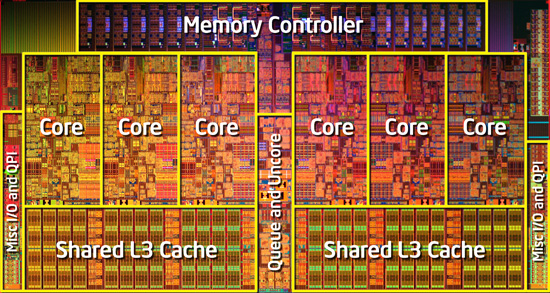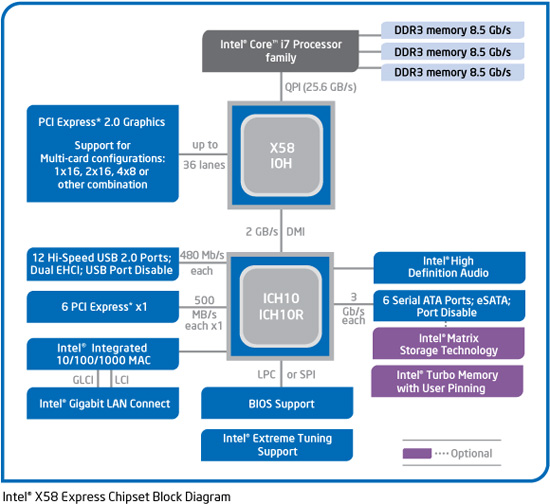The Core i7 980X Review: Intel's First 6-Core Desktop CPU
by Anand Lal Shimpi on March 11, 2010 12:00 AM EST- Posted in
- CPUs
A 12MB L3 Cache: 50% Larger, 14% Higher Latency
Gulftown sticks to Ronak’s 2MB of L3 per core rule and has a full, 12MB shared L3 cache that’s accessible by any or all of the six cores. It’s actually because of the large unified L3 cache that performance in applications that don’t use all six cores can be higher than quad-core Core i7s.

Nehalem

Gulftown
The added cache does come at the expense of higher access latency. Nehalem and Lynnfield had a 42-cycle 8MB L3, Gulftown has a 48 cycle 12MB L3. A 14% higher latency for a 50% increase in size. Not an insignificant penalty, but a tradeoff that makes sense.
Identical Power Consumption to the Core i7 975
Raja has been busy with his DC clamp meter measuring actual power consumption of CPUs themselves rather than measuring power consumption at the wall. The results below compare the actual power draw of the 32nm Core i7 980X to the 45nm Core i7 975. These values are just the CPU itself, the rest of the system is completely removed from the equation:
| CPU | Intel Core i7 980X | Intel Core i7 975 |
| Idle | 6.3W | 6.3W |
| Load | 136.8W | 133.2W |
Thanks to power gating, both of these chips idle at 6.3W. That's ridiculous for a 1.17B transistor chip. Under full load, the two are virtually identical - both drawing around 136W.
Westmere Goodness
The Core i7 980X is the first LGA-1366 processor based on Intel’s Westmere architecture, but unlike Clarkdale it does not have an on-die PCIe controller or on-package graphics. If anything, Gulftown really looks like a 6-core, 32nm version of Bloomfield rather than a scaled up Clarkdale. The similarities to Bloomfield extend all the way to the memory controller. Gulftown only officially supports three channels of DDR3-1066 memory, not 1333MHz like Lynnfield or Clarkdale. Of course running DDR3-1333 memory is possible, but the memory controller is technically operating out of spec at that frequency.

The processor does retain the Westmere specific features. The first Core i7 did not power gate its L3 cache, Lynnfield added it and Gulftown has it as well. While Mainly improved power efficiency and AES-NI instructions. I looked at the performance improvement offered by AES-NI acceleration in our Clarkdale review. If you use BitLocker or do a lot of archive encryption/decryption, you'll appreciate Gulftown's AES-NI.










102 Comments
View All Comments
cactusdog - Thursday, March 11, 2010 - link
This wont be the only i7 6 core desktop CPU. Intel are being sneaky to milk the market. There will be another one or possibly 2 at mainstream prices. The cheapest Xeon gulftown is only $400 (2.26Ghz) so why would Intel ignore desktop when X58 boards will happily run a Xeon?GourdFreeMan - Thursday, March 11, 2010 - link
That strategy could just as well backfire on Intel. If you have to wait six months for the other hexacore desktop Gulftowns, you might as well forgo Gulftown entirely and wait a year to fifteen months for hexa/octocore Sandy Bridge. The new AVX instructions in Sandy Bridge are likely to have a far broader impact on performance in terms of software anyway...Triple Omega - Thursday, March 11, 2010 - link
Well I hope you're right. As right now it looks like even Sandy Bridge releasing at least 26 months after the 920 will still have only 4 cores maximum. Not much of a replacement.Also, did anyone notice they broke their own Moore's-Law rule? The 980X only has 1,6 times the transistors of it's predecessor.
DrMrLordX - Friday, March 12, 2010 - link
As I posted above:http://en.wikipedia.org/wiki/List_of_future_Intel_...">http://en.wikipedia.org/wiki/List_of_fu...rocessor...
JumpingJack - Thursday, March 11, 2010 - link
"Also, did anyone notice they broke their own Moore's-Law rule? The 980X only has 1,6 times the transistors of it's predecessor. "You have a fundamental misunderstanding of Moore's Law, this is not unexpected because it is often misquoted or misrepresented in the less technically oriented press. The proper way to state Moore's law is the transistor count will double roughly every two years for the same die size, or for the same transistor count the die size will half. Yet the best way is to simply say the transistor density (transistor/unit area) will double.
You can check the 32 nm adherence to Moore's law by following up on the technical presentations that float around the web, Intel published their IEDM 2009 32 nm stuff:
Also, did anyone notice they broke their own Moore's-Law rule? The 980X only has 1,6 times the transistors of it's predecessor.
http://download.intel.com/technology/architecture-...">http://download.intel.com/technology/ar...-silicon...
See the scaling for gate pitch or SRAM cell size slides 5 and 6, they are clearly falling right on the Moore's law path.
This is not by accident, a linear scaling factor of 0.7 when squared is 0.49 or roughly 0.5 i.e. half the area, this factor is chosen to get double the transistor density each technology node.
talonz - Thursday, March 11, 2010 - link
"Moore's Law" refers to density, not actual transistor count. Anyone can build a big chip.tterremmotto - Thursday, March 11, 2010 - link
Actually, Moore's law has nothing to do with density nor speed. It was about price.Moore's "observation" simply stated that the price per transistor halves every 18 moths. Wether that is due to density increases or process advancement is not a necessity.
Never an observation has been so misunderstood, and yet have such a fantastic side effect.
JKflipflop98 - Thursday, March 11, 2010 - link
Actually, Moore's law is all about transistor density. I know. I see it everyday in the halls, in the elevator, at my desk, in the cleanroom. . .JumpingJack - Thursday, March 11, 2010 - link
He has a small point, Moores Law is just an obseravtion of the rate of shrinkage over time, the phenomena is driven by the economy of scale.Jack
softdrinkviking - Thursday, March 11, 2010 - link
where are you getting your xeon pricing info from?all i can find from any solid source is the current xeon quad core processors which are running about $2000 on newegg at the moment.
xeons have always carried a premium for the intel dual processor support, and imho, a cheaper xeon is going to be more "enterprise" oriented and not be a real upgrade for the home x58 platform.
again, this is pure speculation, but i think we are going to be stuck with our current i7 stuff until intel decides to do a 32 nm refresh on the home line up.
basically, what i'm trying to say is that i think any xeon capable of creaming an i7 930 is going to be WAY more expensive than the 980x gulftown on display here.